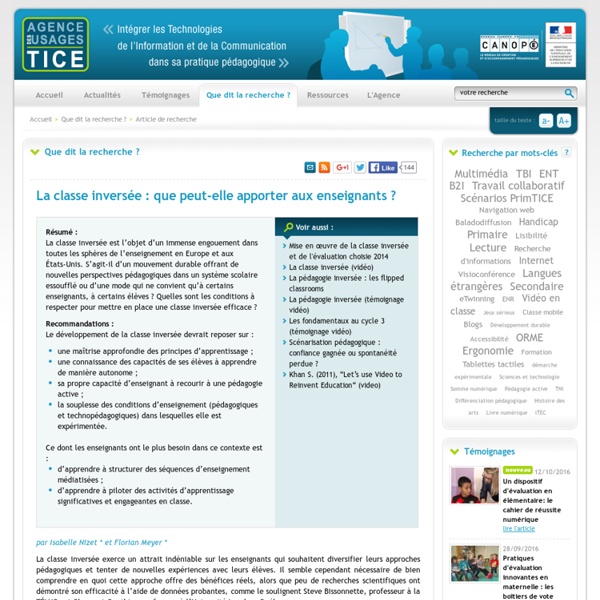



5 technologies to avoid in the classroom-and what to use instead 3. Untested Apps and Online Tools: Thanks to the explosive growth of mobile technology and its use in education, apps and digital resources and tools across a host of platforms are also available…perhaps dizzyingly so. Checking education apps and tools on any large platform, like the Apple Store, for educator-based comments and reviews is tedious; and often challenges like apps and tools that are never updated, or apps and tools that don’t actually perform as promised cause more headaches then they’re worth. Better Option? Andrew Feenberg's Website - Selected Articles Special Issue of Techne,Volume 17, Issue 1, Winter 2013, "Extending Feenberg: Toward the Instrumentalization of the Critical Theory of Technology," abstracts [web link] Book Symposium on Between Reason and Experience: Essays in Technology and Modernity, June 2011. [web link] [PDF] Reflections on "L’écologie des autres.
The Teacher's Guide To Flipped Classrooms Since Jonathan Bergman and Aaron Sams first experimented with the idea in their Colorado classrooms in 2004, flipped learning has exploded onto the larger educational scene. It’s been one of the hottest topics in education for several years running and doesn’t seem to be losing steam. Basically, it all started when Bergman and Sams first came across a technology that makes it easy to record videos. They had a lot of students that regularly missed class and saw an opportunity to make sure that missing class didn’t mean missing out on the lessons. Parenting for a Digital Future – Coding for what? Because this week is National Coding Week in the UK, we are discussing the potential consequences of young people learning to code. While there is legitimate and growing call for kids to learn to code, it is essential that we think carefully and critically about what that entails. In light of potential risks or destructive effects, this post by Ben Williamson explores why coding needs to be taught with a commitment to exploring social consequences. He argues that if kids need to learn to code, it should be for the purposes of digital citizenship rather than participating in computational propaganda. Ben Williamson studies “network governance” in education policy, and is leading a project exploring how computer code interacts with educational institutions, pedagogic practices, and governing processes.
Revue Sticef.org - Une approche sociocritique des usages numériques en éducation Simon COLLIN (CRIFPE, Université du Québec à Montréal), Nicolas GUICHON (ICAR, Université Lumière Lyon 2), Jean Gabin NTÉBUTSÉ (CERTA, Université de Sherbrooke) 1. Introduction « It is contended that more research is required that moves away from a ‘means-end’ way of thinking about how best to harness the presumed inherent educational potential of digital technology and, instead, focuses on the socially contested and socially shaped nature of technology », (p. 66). The flipped classroom: six myths – Kris Shaffer What is the flipped classroom? According to many in the educational technology business, it’s using online video to deliver lectures to students and personalize the learning process. However, if you read the work of education researchers, the flipped class model is more about promoting active learning in class, in pursuit of higher-level, critical thinking skills. So which is it? I’d rather not get into the business of erecting fences and proclaiming who is in and who is out.
Five tips on how to reinvent remote teaching The Covid-19 health crisis has made remote teaching a reality for all, but not without difficulty. At our University, our students have been learning remotely for almost a year and the successive lockdowns have taken their toll. At the start, we battled with technical difficulties, poor Internet connections and insufficient IT equipment while we struggled to isolate ourselves from others.
Abstract Announcement for IJBIDE 1(1) Receive one-time update if document changes: The contents of the latest issue of:International Journal of Bias, Identity and Diversities in Education (IJBIDE)Volume 1, Issue 1, January - June 2016Published: Semi-Annually in Print and ElectronicallyISSN: 2379-7363; EISSN: 2379-7355; Published by IGI Global Publishing, Hershey, USAwww.igi-global.com/ijbide Editor-in-Chief: Fred Dervin (University of Helsinki, Finland), Regis Machart (Universiti Putra Malaysia, Malaysia) and Julie Byrd Clark (Western University, Canada) Note: There are no submission or acceptance fees for manuscripts submitted to the International Journal of Bias, Identity and Diversities in Education (IJBIDE). All manuscripts are accepted based on a double-blind peer review editorial process. Editorial Preface
The Top 5 Blended And Flipped Classroom Tools Blended and Flipped Classrooms can give students more control over their learning path. Added to that, the teachers get more insight into the learning of the class and can intervene as required. Technology plays an important role in blending the classrooms. User-friendly technology ensures that the student has more control over the time, place and pace of the curriculum. It also ensures that the teacher has the necessary visibility and tools to intervene effectively. Researchers This site is designed with several different kinds of user in mind. This is reflected in the menu items across the top of every page. Complete beginner